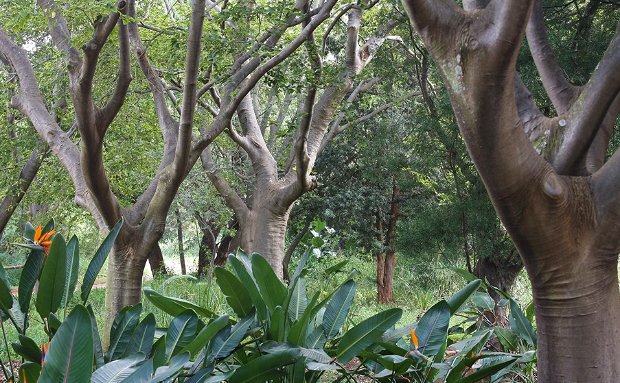Mountain Camp Astrology Experience Join us at Vallley of the Rainbow Fly Fishing Estate and Wilderness Retreat for a stargazing experience. Sleep over on the mountaintop with family and friends and experience the wonder of an unpolluted African night sky. The best stargazing opportunities are during a new moon when the moon is not in the sky at night. The night skies can still be enjoyed during other phases of the lunar...
Forests - Heroes of Nature

Contribute to our re-forestation project by taking ownership of your own indigenous tree, planted in the valley.
The Valley of the Rainbow Tree Planting Project is an opportunity to give back to nature.
Deforestation remains one of the largest threats to the environment. Many hectares of forests are lost each year due to deforestation. Experts predict that large areas in the world will be a desert if the indiscriminate cutting of trees continues unabated.
Deforestation is the removal of a forest (or trees), after which the cleared land is converted for commercial or agricultural use. Mining activities have contributed significantly to deforestation in South Africa.
The negative effects of deforestation are many:
1. The removal of trees without sufficient reforestation has resulted in damage to the natural habitat, loss of biodiversity, and aridity.
2. It has an adverse impact on bio-sequestration or storage of atmospheric carbon dioxide by plants. Deforested regions typically incur significant adverse soil erosion and frequently degrade into wasteland.
3. Deforestation causes extinction, changes to climate conditions, desertification, and displacement of populations.
According to the United Nations Framework Convention on Climate Change secretariat, the overwhelming direct cause of deforestation is agriculture. Subsistence farming is responsible for 48% of deforestation.
Deforestation is a contributor to global warming and is often cited as one of the major causes of the enhanced greenhouse effect.
Deforestation also causes carbon dioxide to linger in the atmosphere. As the carbon dioxide accrues, it produces a layer in the atmosphere that traps radiation from the sun. The radiation converts to heat, which causes global warming, which is better known as the greenhouse effect.
This is why plants, and trees, are so critical to the planet. Plants remove carbon in the form of carbon dioxide from the atmosphere during the process of photosynthesis, but release some carbon dioxide back into the atmosphere during normal respiration. Only when it is actively growing can a tree or forest remove carbon, by storing it in plant tissues. Both the decay and burning of wood releases much of this stored carbon back in the atmosphere.
In order for forests to absorb carbon, there must be a net accumulation of wood which can be achieved by replacing cut trees. The water cycle is also affected by deforestation. Trees extract groundwater through their roots and release it into the atmosphere. When part of a forest is removed, the trees no longer transpire this water, resulting in a much drier climate. Deforestation reduces the content of water in the soil and groundwater as well as atmospheric moisture.
The dry soil leads to lower water intake for the trees to extract. Deforestation reduces soil cohesion, so that erosion, flooding and landslides ensue.
Instead of trapping precipitation, which then percolates to groundwater systems, deforested areas become sources of surface water runoff, which moves much faster than subsurface flows. That quick movement of surface water can translate into flash flooding.
Trees, and plants in general, affect the water cycle significantly. Their canopies intercept a proportion of precipitation, which is then evaporated back to the atmosphere. Plant litter, stems, and tree trunks slow down surface run-off. Their roots create macropores — large conduits — in the soil that increase infiltration of water. This contributes to terrestrial evaporation and reduces soil moisture via transpiration. Plant litter and other organic residue change soil properties that affect the capacity of soil to store water. Leaves control the humidity of the atmosphere by transpiring.
As a result, the presence or absence of trees can change the quantity of water on the surface, in the soil or underground or in the atmosphere. This in turn changes erosion rates and the availability of water for either ecosystem functions or human services.
Deforestation has accelerated sharply across the country in recent years due to power challenges and mining activities. In the past few years, South Africa has witnessed illegal farming, mining, and settlements in forest areas previously set aside as water catchment areas. This has led to the rampant cutting down of trees for various reasons. The resultant deforestation has led to heavy siltation of our water bodies leading to limited water supplies for different activities that have an impact on livelihoods.
The Valley of the Rainbow Planting Days will be commemorated under the theme, “Forests for water and life”. This theme serves to remind us of forests’ importance, including guaranteeing water quality and supply. Through the Valley of the Rainbow Tree Planting Day campaign, we aim to highlight the need for sustainable management and protection of forests to preserve their benefits, including water provision.
Further Reading
Are you caught up in traffic for long hours, anxious about your health and wellbeing, or battling the stress of day to day life? It’s time to take a break, relax, and head outdoors to experience nature!





Share This Post